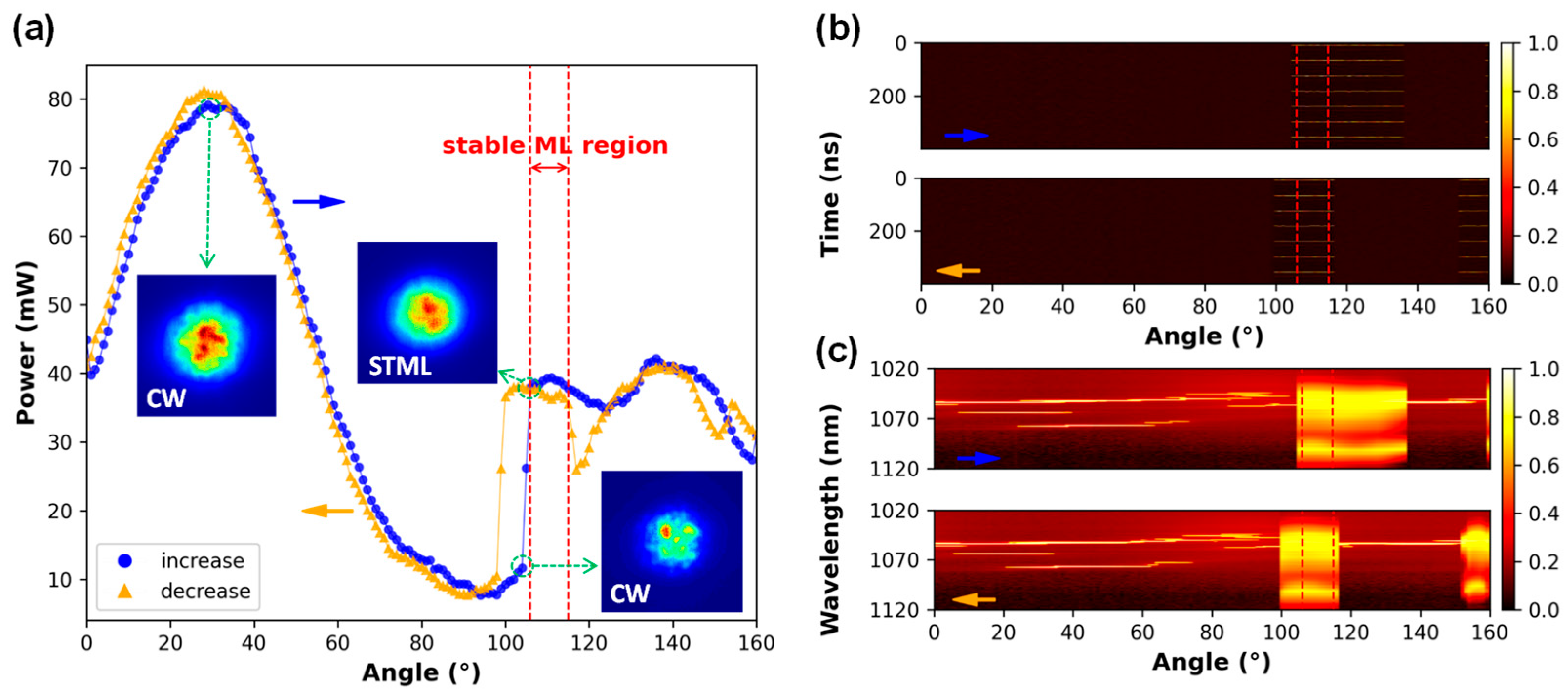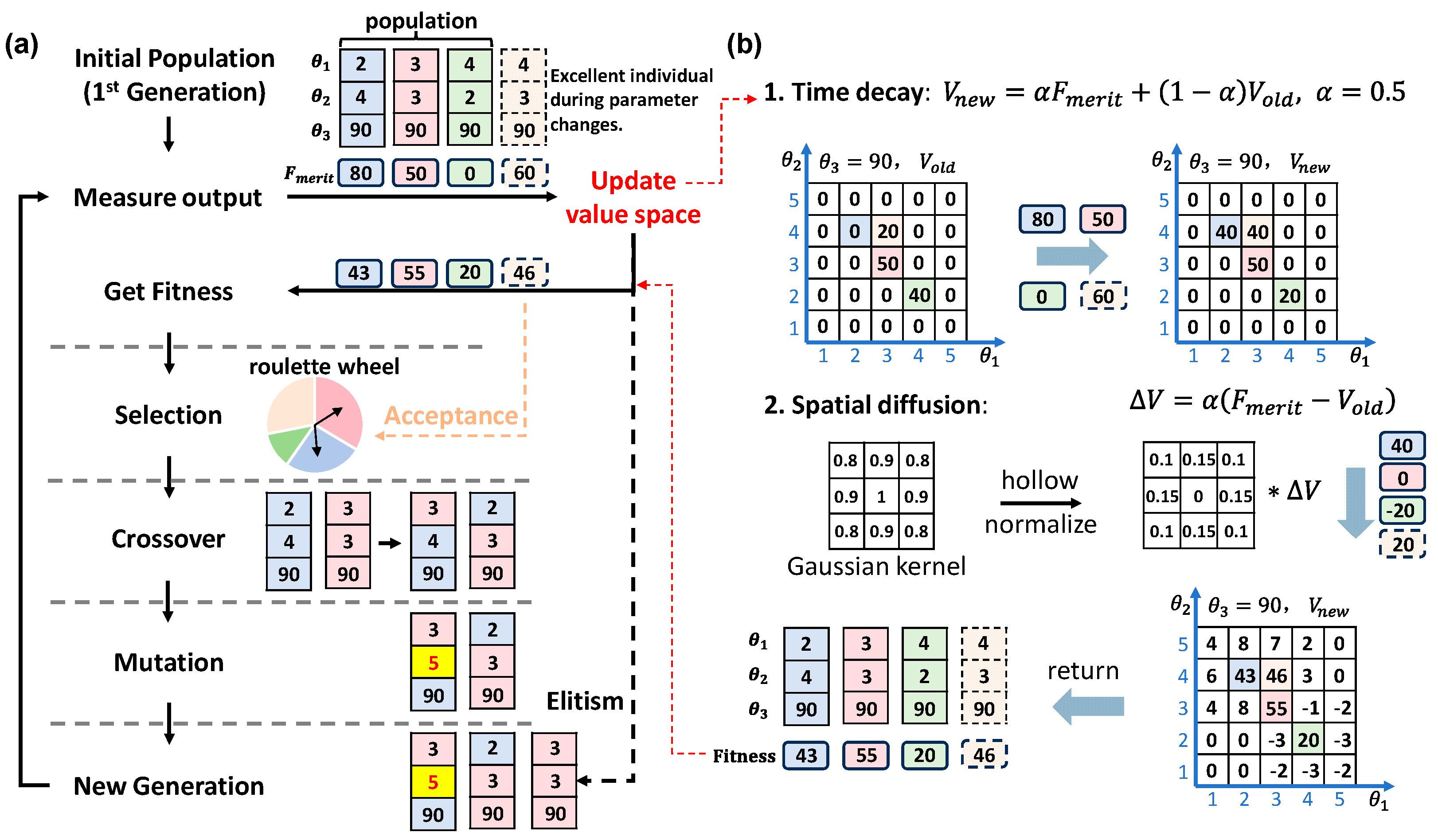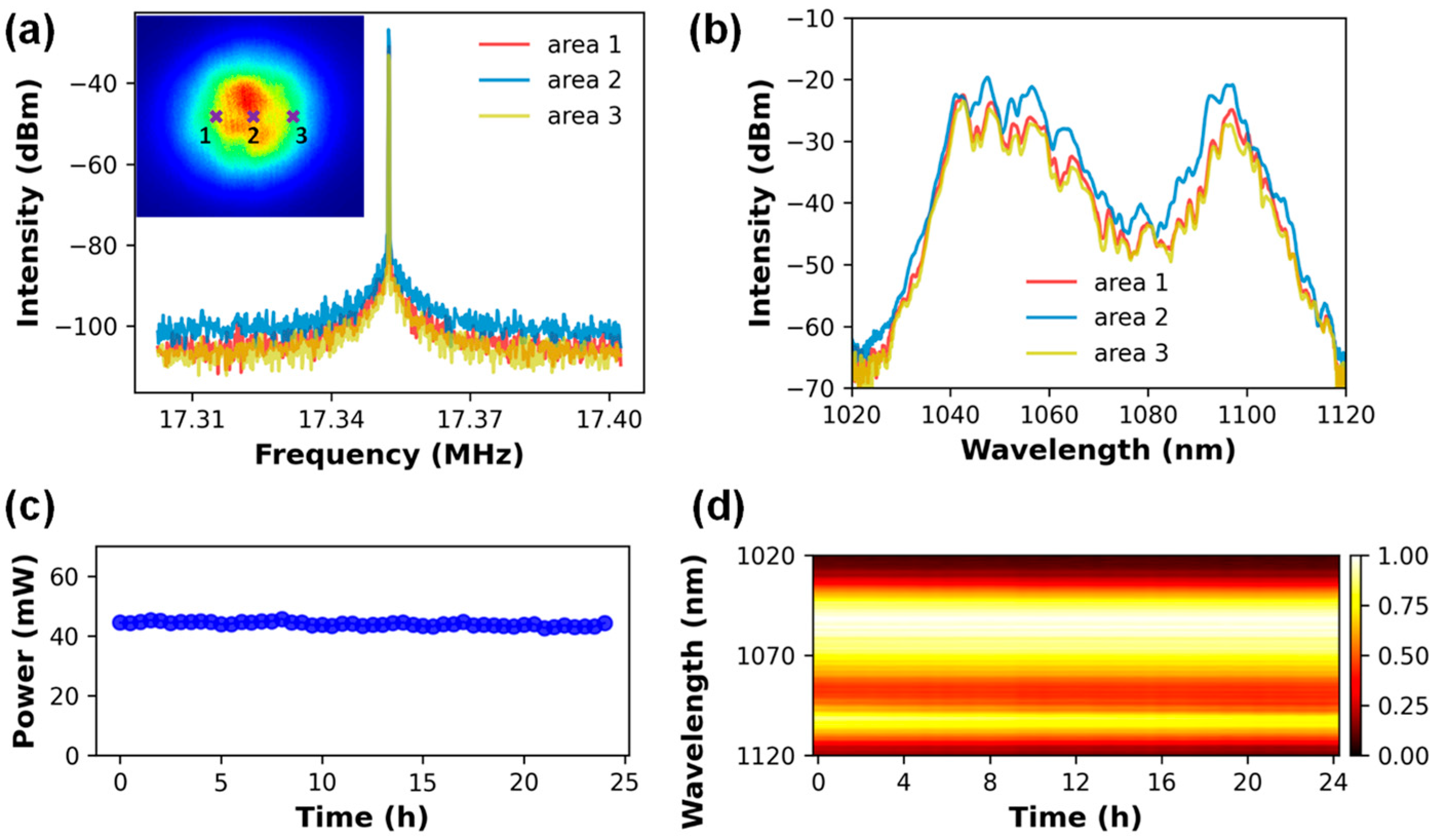Genetic-Algorithm-Driven Intelligent Spatiotemporal Mode-Locking in All-Fiber Laser with Hysteresis
Abstract
1. Introduction
2. Experimental Setup and Methods
2.1. Experimental Setup
2.2. Hysteresis
2.3. Memory-Diffusion Genetic Algorithm
3. Experimental Results and Discussion
4. Conclusions
Author Contributions
Funding
Institutional Review Board Statement
Informed Consent Statement
Data Availability Statement
Conflicts of Interest
References
- Grelu, P.; Akhmediev, N. Dissipative solitons for mode-locked lasers. Nat. Photonics 2012, 6, 84–92. [Google Scholar] [CrossRef]
- Geng, J.; Yan, W.; Shi, L.; Qiu, M. Surface plasmons interference nanogratings: Wafer-scale laser direct structuring in seconds. Light Sci. Appl. 2022, 11, 189. [Google Scholar] [CrossRef]
- Richardson, D.J.; Fini, J.M.; Nelson, L.E. Space-division multiplexing in optical fibres. Nat. Photonics 2013, 7, 354–362. [Google Scholar] [CrossRef]
- Tegin, U.; Rahmani, B.; Kakkava, E.; Psaltis, D.; Moser, C. Single-mode output by controlling the spatiotemporal nonlinearities in mode-locked femtosecond multimode fiber lasers. Adv. Photonics 2020, 2, 056005. [Google Scholar] [CrossRef]
- Wright, L.G.; Christodoulides, D.N.; Wise, F.W. Spatiotemporal mode-locking in multimode fiber lasers. Science 2017, 358, 94–97. [Google Scholar] [CrossRef]
- Wright, L.G.; Sidorenko, P.; Pourbeyram, H.; Ziegler, Z.M.; Isichenko, A.; Malomed, B.A.; Menyuk, C.R.; Christodoulides, D.N.; Wise, F.W. Mechanisms of spatiotemporal mode-locking. Nat. Phys. 2020, 16, 565–570. [Google Scholar] [CrossRef]
- Ding, Y.; Xiao, X.; Liu, K.; Fan, S.; Zhang, X.; Yang, C. Spatiotemporal Mode-Locking in Lasers with Large Modal Dispersion. Phys. Rev. Lett. 2021, 126, 093901. [Google Scholar] [CrossRef]
- Teğin, U.; Kakkava, E.; Rahmani, B.; Psaltis, D.; Moser, C. Spatiotemporal self-similar fiber laser. Optica 2019, 6, 1412–1415. [Google Scholar] [CrossRef]
- Guo, T.; Wang, Z.; Gao, F.; Zhao, C.; Chang, S.; Zhang, X. All fiber spatiotemporal mode-locked fiber laser at 1.55 μm delivering multimode conventional solitons or bound solitons. Opt. Laser Technol. 2022, 152, 108093. [Google Scholar] [CrossRef]
- Liu, K.; Xiao, X.; Ding, Y.; Peng, H.; Lv, D.; Yang, C. Buildup dynamics of multiple solitons in spatiotemporal mode-locked fiber lasers. Photonics Res. 2021, 9, 1898–1906. [Google Scholar] [CrossRef]
- Liu, K.; Xiao, X.; Yang, C. Observation of transition between multimode Q-switching and spatiotemporal mode locking. Photonics Res. 2021, 9, 530–534. [Google Scholar] [CrossRef]
- Guo, Y.; Wen, X.; Lin, W.; Wang, W.; Wei, X.; Yang, Z. Real-time multispeckle spectral-temporal measurement unveils the complexity of spatiotemporal solitons. Nat. Commun. 2021, 12, 67. [Google Scholar] [CrossRef]
- Fu, G.; Li, Y.; Xiao, Q.; Li, D.; Gong, M.; Liu, Q.; Wabnitz, S.; Yan, P. Spatiotemporal dissipation dynamics: A route to high-beam-quality and high-peak-power spatiotemporal mode-locked fiber lasers. Optica 2024, 11, 1503–1510. [Google Scholar] [CrossRef]
- Zhang, H.; Peng, J.; Xiao, X.; Zhang, W.; Xu, G.; Su, X.; Yan, F.; Zheng, Y.; Yao, J. Dynamics of multimode creeping solitons and soliton explosions in a spatiotemporal mode-locked laser. Opt. Express 2025, 33, 4225–4235. [Google Scholar] [CrossRef] [PubMed]
- Zhang, H.; Lu, J.; Peng, J.; Xiao, X.; Xu, G.; Zhang, Y.; Su, X.; Sun, T.; Zheng, K.; Zheng, Y.; et al. Investigation of High-Power Spatiotemporal Mode-Locking with High Beam Quality. Laser Photonics Rev. 2023, 17, 2300017. [Google Scholar] [CrossRef]
- Krupa, K.; Tonello, A.; Shalaby, B.M.; Fabert, M.; Barthélémy, A.; Millot, G.; Wabnitz, S.; Couderc, V. Spatial beam self-cleaning in multimode fibres. Nat. Photonics 2017, 11, 237–241. [Google Scholar] [CrossRef]
- Qiu, M.; Chen, M.; Zhang, Z. Wavelength-Dependent Kerr Beam Self-Cleaning in Spatiotemporal Mode-Locked Multimode Fiber Laser. IEEE Photonics Technol. Lett. 2021, 33, 1073–1076. [Google Scholar] [CrossRef]
- Fu, G.; Qi, T.; Yu, W.; Wang, L.; Wu, Y.; Pan, X.; Xiao, Q.; Li, D.; Gong, M.; Yan, P. Beam Self-Cleaning of 1.5 μm High Peak-Power Spatiotemporal Mode-Locked Lasers Enabled by Nonlinear Compression and Disorder. Laser Photonics Rev. 2023, 17, 2200987. [Google Scholar] [CrossRef]
- Ma, W.; Li, X.; Qin, Y.; Chen, W.; Hu, G. High-power spatiotemporal mode-locked Yb-doped fiber laser based on transverse modes division control. Opt. Lett. 2025, 50, 5202–5205. [Google Scholar] [CrossRef]
- Hao, W.; Yang, Z.; Mao, M.; Tang, Y. Mode-Controllable and High-Pulse-Energy Spatiotemporally Mode-Locked Fiber Laser. IEEE Photonics J. 2025, 17, 7100406. [Google Scholar] [CrossRef]
- Wei, X.; Jing, J.C.; Shen, Y.; Wang, L.V. Harnessing a multi-dimensional fibre laser using genetic wavefront shaping. Light Sci. Appl. 2020, 9, 149. [Google Scholar] [CrossRef] [PubMed]
- Liu, Z.; Zhang, F.; Qian, Z.; Liu, J.; Dai, L.; Mou, C.; Zhao, L.; Tang, M. Spatiotemporal mode-locked intelligent fiber laser based on cascaded photonic lanterns. Opt. Lett. 2025, 50, 463–466. [Google Scholar] [CrossRef]
- Zhang, H.; Zhang, Y.; Peng, J.; Su, X.; Xiao, X.; Xu, D.; Chen, J.; Sun, T.; Zheng, K.; Yao, J.; et al. All-fiber spatiotemporal mode-locking lasers with large modal dispersion. Photonics Res. 2022, 10, 483–490. [Google Scholar] [CrossRef]
- Li, J.; Chang, K.; Liu, C.; Ning, Y.; Ma, Y.; He, J.; Liu, Y.; Wang, Z. The soft actor–critic algorithm for automatic mode-locked fiber lasers. Opt. Fiber Technol. 2023, 81, 103579. [Google Scholar] [CrossRef]
- Pu, G.; Yi, L.; Zhang, L.; Hu, W. Intelligent programmable mode-locked fiber laser with a human-like algorithm. Optica 2019, 6, 362–369. [Google Scholar] [CrossRef]
- Pu, G.; Zhang, L.; Hu, W.; Yi, L. Automatic mode-locking fiber lasers: Progress and perspectives. Sci. China Inf. Sci. 2020, 63, 160404. [Google Scholar] [CrossRef]
- Andral, U.; Si Fodil, R.; Amrani, F.; Billard, F.; Hertz, E.; Grelu, P. Fiber laser mode locked through an evolutionary algorithm. Optica 2015, 2, 275–278. [Google Scholar] [CrossRef]
- Woodward, R.I.; Kelleher, E.J.R. Towards ‘smart lasers’: Self-optimisation of an ultrafast pulse source using a genetic algorithm. Sci. Rep. 2016, 6, 37616. [Google Scholar] [CrossRef] [PubMed]
- Yao, T.; Qi, L.; Zheng, F.; Zhou, W.; Kang, H.; Zhu, Q.; Song, X.; Liu, G.; Xu, S.; Zhang, Q.; et al. Soliton patterns recognition and searching from a 2 µm intelligent mode-locked fiber laser agent. Opt. Laser Technol. 2025, 182, 112125. [Google Scholar] [CrossRef]
- Zhou, Y.; Yang, K.; Tsia, K.K.; Zeng, H.; Wong, K.K.Y. Intelligent soliton molecules control in an ultrafast thulium fiber laser. Adv. Photonics Nexus 2025, 4, 016012. [Google Scholar] [CrossRef]
- Yan, Q.; Tian, Y.; Zhang, T.; Lv, C.; Meng, F.; Jia, Z.; Qin, W.; Qin, G. Machine Learning Based Automatic Mode-Locking of a Dual-Wavelength Soliton Fiber Laser. Photonics 2024, 11, 47. [Google Scholar] [CrossRef]
- Kokhanovskiy, A.; Shevelev, A.; Serebrennikov, K.; Kuprikov, E.; Turitsyn, S. A Deep Reinforcement Learning Algorithm for Smart Control of Hysteresis Phenomena in a Mode-Locked Fiber Laser. Photonics 2022, 9, 921. [Google Scholar] [CrossRef]
- Komarov, A.; Leblond, H.; Sanchez, F. Multistability and hysteresis phenomena in passively mode-locked fiber lasers. Phys. Rev. A 2005, 71, 053809. [Google Scholar] [CrossRef]
- Wu, H.; Lin, W.; Tan, Y.-J.; Cui, H.; Luo, Z.-C.; Xu, W.-C.; Luo, A.-P. Pulses with switchable wavelengths and hysteresis in an all-fiber spatio-temporal mode-locked laser. Appl. Phys. Express 2020, 13, 022008. [Google Scholar] [CrossRef]
- Salhi, M.; Karar, A.S.; Monga, K.J.-J.; Bahloul, F. Study of transition dynamics from breathing single pulse to higher-order pulses and hysteresis in a figure-of-9 fiber laser. Opt. Commun. 2023, 546, 129822. [Google Scholar] [CrossRef]
- Li, J.; Jiang, W.; Meng, Y.; Wang, F. Hysteresis of a passively mode-locked fiber laser: Effects from cavity dispersion. Opt. Lett. 2022, 47, 5668–5671. [Google Scholar] [CrossRef]
- Ding, Y.; Xiao, X.; Wang, P.; Yang, C. Multiple-soliton in spatiotemporal mode-locked multimode fiber lasers. Opt. Express 2019, 27, 11435–11446. [Google Scholar] [CrossRef] [PubMed]
- Haig, H.; Sidorenko, P.; Dhar, A.; Choudhury, N.; Sen, R.; Christodoulides, D.; Wise, F. Multimode Mamyshev oscillator. Opt. Lett. 2021, 47, 46–49. [Google Scholar] [CrossRef] [PubMed]
- Teğin, U.; Rahmani, B.; Kakkava, E.; Psaltis, D.; Moser, C. All-fiber spatiotemporally mode-locked laser with multimode fiber-based filtering. Opt. Express 2020, 28, 23433–23438. [Google Scholar] [CrossRef]
- Lin, X.-B.; Gao, Y.-X.; Long, J.-G.; Wu, J.-W.; Hong, W.-Y.; Cui, H.; Luo, Z.-C.; Xu, W.-C.; Luo, A.-P. All Few-mode Fiber Spatiotemporal Mode-Locked Figure-eight Laser. J. Light. Technol. 2021, 39, 5611–5616. [Google Scholar] [CrossRef]
- Lou, Y.; Ge, B.; Gou, S.; Wang, A.; Cai, Y.; Zhang, X. Ultrafast Flat-Top Beam Emission with an All-Fiber Multimode Laser. ACS Photonics 2024, 11, 1901–1908. [Google Scholar] [CrossRef]
- Qiu, H.; Yao, Y.; Yang, Y.; Guo, L.; Li, S.; Xu, X.; Tian, J.; Yang, Y. Multi-state broadband spectrum and ultra-short pulse spatiotemporal mode-locked Yb-doped multimode fiber laser. Opt. Laser Technol. 2025, 182, 112149. [Google Scholar] [CrossRef]
- Long, R.; Wen, J.; Li, Y.; Huang, L.; Fan, D.; Jiang, G.; Chen, Y. Spatiotemporal flat-top beam generated from an all-fiber mode-locking laser. Opt. Express 2025, 33, 583–591. [Google Scholar] [CrossRef] [PubMed]







| ML Mechanism | Gain Fiber (μm) | Average Output (mW) | Single-Pulse Energy (nJ) | Ref. |
|---|---|---|---|---|
| MMI | YDF (10/125) | 12 | 0.5 | [39] |
| NALM | YDF (10/125) | 1.304 | 0.195 | [40] |
| NPR | YDF (20/125) | 232.2 | 8 | [23] |
| QD | YDF (10/125) | 70.4 | 4.4 | [41] |
| NPR | YDF (10/125) | 43.1 | 2.15 | [42] |
| NOLM | YDF (5/130) | 4.4 | 4.1 | [43] |
| NPR | YDF (20/130) | 148.7 | 8.6 | This work |
Disclaimer/Publisher’s Note: The statements, opinions and data contained in all publications are solely those of the individual author(s) and contributor(s) and not of MDPI and/or the editor(s). MDPI and/or the editor(s) disclaim responsibility for any injury to people or property resulting from any ideas, methods, instructions or products referred to in the content. |
© 2025 by the authors. Licensee MDPI, Basel, Switzerland. This article is an open access article distributed under the terms and conditions of the Creative Commons Attribution (CC BY) license (https://creativecommons.org/licenses/by/4.0/).
Share and Cite
Lin, Y.; Zheng, Y.; Zhang, X. Genetic-Algorithm-Driven Intelligent Spatiotemporal Mode-Locking in All-Fiber Laser with Hysteresis. Photonics 2025, 12, 1138. https://doi.org/10.3390/photonics12111138
Lin Y, Zheng Y, Zhang X. Genetic-Algorithm-Driven Intelligent Spatiotemporal Mode-Locking in All-Fiber Laser with Hysteresis. Photonics. 2025; 12(11):1138. https://doi.org/10.3390/photonics12111138
Chicago/Turabian StyleLin, Yangbing, Yongguo Zheng, and Xinhai Zhang. 2025. "Genetic-Algorithm-Driven Intelligent Spatiotemporal Mode-Locking in All-Fiber Laser with Hysteresis" Photonics 12, no. 11: 1138. https://doi.org/10.3390/photonics12111138
APA StyleLin, Y., Zheng, Y., & Zhang, X. (2025). Genetic-Algorithm-Driven Intelligent Spatiotemporal Mode-Locking in All-Fiber Laser with Hysteresis. Photonics, 12(11), 1138. https://doi.org/10.3390/photonics12111138




